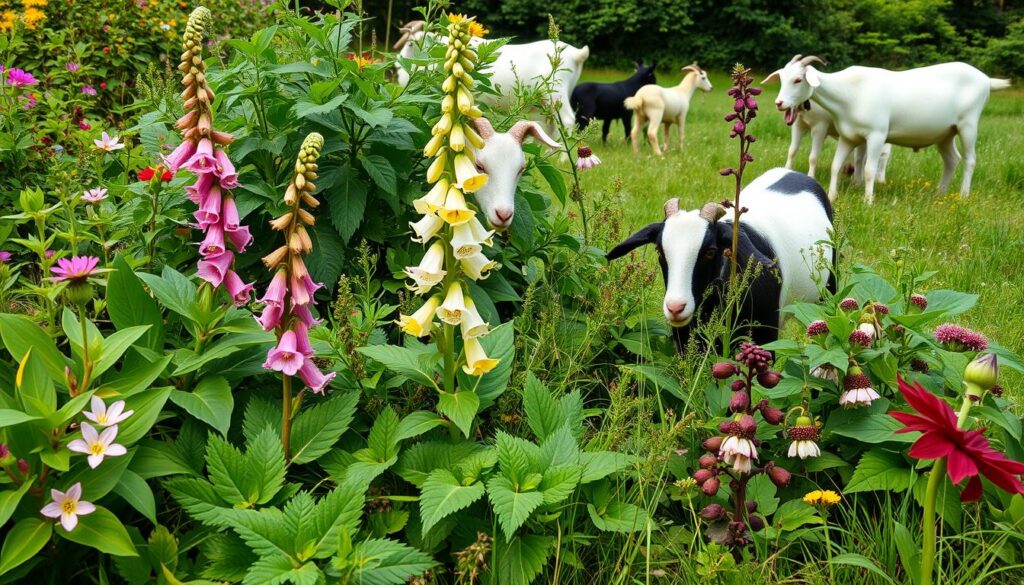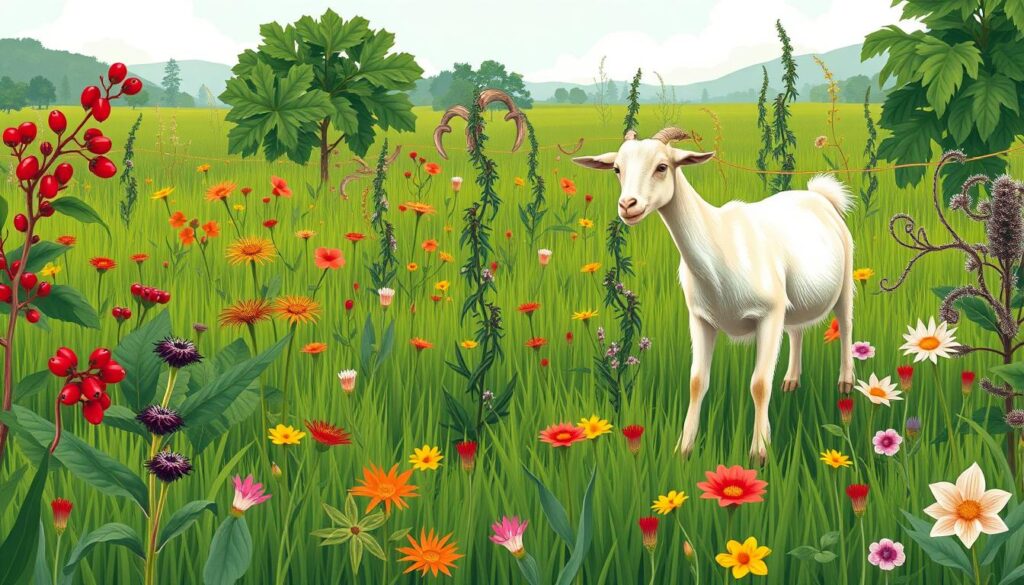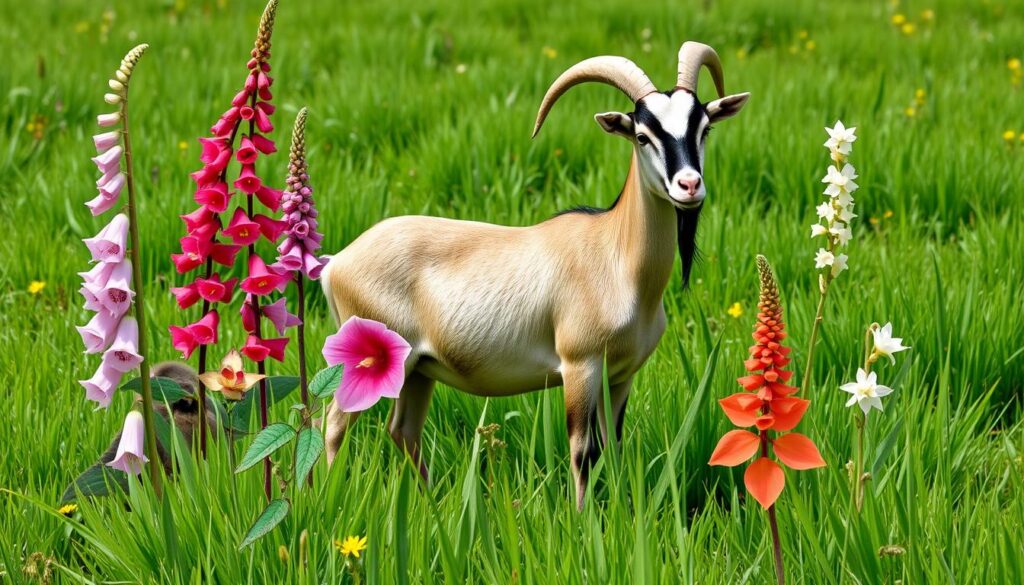As a goat owner, you know how important their health is. But have you thought about dangers in your pasture or garden? Some plants in the U.S. can be toxic to goats. It’s vital to know which plants are poisonous to your goats.
It’s crucial to keep your goats safe from poisonous plants. By knowing the risks and taking steps to prevent them, you can protect your goats. So, what plants should you avoid, and how can you keep your goats safe from plant poisoning?
Key Takeaways
- Goats are vulnerable to plant poisoning due to their unique digestive system and grazing habits.
- Poisonous plants for goats can be found in pastures, along fences, and even in gardens.
- Toxic plants for goats can cause a range of health problems, from mild illness to death.
- Understanding the risks and taking preventive measures are key to protecting your herd.
- Regular monitoring and maintenance of your pasture and garden can help prevent plant poisoning.
- Education and awareness are crucial in identifying and avoiding poisonous plants for goats.
Understanding the Risk of Toxic Plants to Your Goat Herd
As a goat owner, it’s key to know about plants harmful to goats. These plants are everywhere, and goats might eat them out of curiosity. Their unique digestive system makes them more likely to get sick from plants.
It’s important to understand that common poisonous plants for goats can harm their health a lot. Plant poisoning can cause mild symptoms or even death. So, knowing the risks and protecting your goats is crucial.
Why Goats Are Vulnerable to Plant Poisoning
Goats are more likely to get sick from plants because of how they eat and digest. Their four-chambered stomach helps them get nutrients from plants. But, it also lets them absorb toxins more easily.
Common Misconceptions About Goat Grazing
Some people think all plants are safe for goats or that they know which ones to avoid. But, this isn’t true. It’s up to the owner to keep their goats safe from harmful plants.

The Impact of Poisonous Plants on Goat Health
Poisonous plants can really hurt a goat’s health. If you think your goat ate something bad, get vet help right away. Knowing the risks and taking steps to prevent them can keep your goats safe from common poisonous plants for goats.
Most Common Poisonous Plants for Goats in America
As a goat owner, knowing the poisonous plants list for goats is key. Plants like oleander, hemlock, and yew are common dangers. They can be found in pastures and gardens across America.
It’s important to know which plants to avoid. This is crucial when adding new plants or letting goats graze in new areas. Here are some common poisonous plants for goats in America:
- Oleander: a toxic plant that can cause cardiac problems in goats
- Hemlock: a highly toxic plant that can be fatal to goats if ingested
- Yew: a plant that contains toxic compounds that can cause respiratory failure in goats
Always check a poisonous plants list for goats to know the risks in your area. By being cautious and aware, you can protect your goats from harm.

How to Identify Dangerous Plants in Your Pasture
As a goat owner, knowing which plants in your pasture are harmful is key. You need knowledge and the right tools to spot toxic plants for goats. By learning what to look for, you can lower the risk of your goats getting sick from plants.
Identifying toxic plants for goats means paying attention to each plant’s unique features. Visual identification tips include spotting distinctive leaves, flowers, or berries. For instance, plants with white or yellow berries are often bad for goats.
Visual Identification Tips
- Look for plants with distinctive leaves, flowers, or berries
- Be aware of plants with white or yellow berries, as they are often toxic
- Check for plants with a strong, unpleasant odor
Related : Caring for Goats on a Backyard Farm
Using Plant Identification Apps
Plant identification apps are super helpful for finding out which plants are toxic to goats. These apps have big databases of plants and their traits. They make it easier to figure out what’s in your pasture.
Seasonal Growth Patterns
Knowing when plants grow in your pasture is important. By understanding seasonal patterns, you can prepare and keep your goats safe from harmful plants.
Toxic Trees and Shrubs That Threaten Goats
As a goat owner, knowing about toxic plants for goats is crucial. Trees and shrubs can be as dangerous as smaller plants. For example, black locust and cherry trees have toxins that can harm goats if they eat them.
Some common toxic plants for goats include:
- Black locust
- Cherry tree
- Yew
- Oak
To keep your goats safe, you need to know which plants are toxic. You should remove these plants or fence off areas where they grow. Always watch your goats when they’re grazing. This way, you can protect them from harmful plants.
It’s always safer to be cautious with your goats’ health. If you’re not sure about a plant, ask a vet or an expert. They can help you make sure your goats are safe.
| Plant | Toxin | Symptoms |
|---|---|---|
| Black locust | Cyanide | Vomiting, diarrhea, abdominal pain |
| Cherry tree | Amygdalin | Vomiting, diarrhea, difficulty breathing |
Garden Plants and Ornamentals That Can Harm Your Herd
When you take care of your garden, think about the dangers some plants can pose to your goats. Many garden plants and ornamentals can be poisonous plants for goats. It’s important to know which ones to watch out for in your garden.
Some common dangers include lily of the valley, daffodils, and tulips. These plants are often in gardens but can be plants harmful to goats if eaten. Make sure to remove any toxic plants and replace them with safe ones.
Decorative Plants to Remove
- Lily of the valley
- Daffodils
- Tulips
Safe Alternatives for Your Garden
Creating a garden safe for goats not only keeps them safe but also makes your garden healthier. By picking non-toxic plants, you can have a beautiful garden while keeping your goats safe from poisonous plants for goats.
Always put your goats’ safety first by watching out for toxic plants in your garden. With some planning and knowledge, you can make a safe and fun space for both you and your goats.
| Plant | Toxicity |
|---|---|
| Lily of the valley | Highly toxic |
| Daffodils | Toxic |
| Tulips | Toxic |
Signs and Symptoms of Plant Poisoning in Goats
As a goat owner, knowing the signs of plant poisoning is key. Poisonous plants symptoms in goats can vary from mild to severe. They might show lethargy, loss of appetite, or stomach pain. In bad cases, goats can have seizures, trouble breathing, or even die.
Watching your goats closely is very important. This is true, even more so when they’re in new places. Some common signs of poisoning include:
- Lack of coordination or balance
- Abnormal heart rate or rhythm
- Vomiting or diarrhea
- Excessive salivation or foaming at the mouth
Also, look out for signs that aren’t as obvious, like changes in how much they eat or drink. If you think your goat ate something bad, get them to a vet right away.
Knowing the signs of plant poisoning helps you act fast to help your goats. Always put your goats’ health first. If you’re not sure about their care, get help from a vet.
Emergency Response to Plant Poisoning
When dealing with goat health and the risk of toxic plants, it’s crucial to have an emergency response plan in place. If you suspect your goat has ingested a toxic plant, every minute counts. Your first step should be to remove the goat from the source of the toxin to prevent further ingestion.
A key part of your emergency response plan is knowing when to contact your veterinarian. If you suspect poisoning, don’t hesitate to reach out, even if it’s just for advice. Your veterinarian can provide guidance on immediate actions to take and recommend any necessary treatments.
Immediate Actions to Take
- Remove the goat from the source of the toxin
- Contact your veterinarian for advice and guidance
- Administer any recommended treatments
Keeping detailed records of the incident, including the plant involved, symptoms, and treatment provided, can be invaluable for future reference and for your veterinarian’s ongoing care of your goats. By being prepared and acting quickly, you can help protect your goats from the dangers of toxic plants and ensure their overall goat health.
Preventing Access to Poisonous Plants
As a goat owner, it’s crucial to keep your goats away from harmful plants. These plants can be found in many places. Knowing the risks and taking steps to avoid them is key.
To keep your goats safe, use fencing and containment strategies. Also, manage your pasture well. This way, you can reduce the risk of your goats eating poisonous plants.
Fencing and Containment Strategies
Secure fencing is a great way to keep goats away from harmful plants. Make sure your pasture fence is strong. Fix any weak spots to keep your goats safe.
Pasture Management Techniques
Managing your pasture is also important. Rotate your goats to different areas. This helps prevent overgrazing and reduces the chance of them eating toxic plants.
- Check your pasture regularly for toxic plants.
- Remove any harmful plants you find.
- Feed your goats a balanced diet. This can help them avoid toxic plants.
Seasonal Considerations for Plant Toxicity
Managing your pasture is key to keeping your goats safe from toxic plants for goats. Seasonal changes can affect how dangerous these plants are. Some plants are more toxic at certain times of the year.
For instance, some plants are more toxic in the spring when they bloom. Others become more hazardous in the fall as they dry out. Knowing these changes helps you adjust grazing to keep your goats safe. Here are some important points:
- Spring: Plants like azalea and rhododendron are more toxic during this season due to their blooming flowers.
- Summer: Plants like poison ivy and oak are more prevalent and can cause skin irritation and other health issues.
- Fall: Plants like hemlock and nightshade can become more toxic as they dry out and produce seeds.
Understanding these seasonal changes helps you manage your pasture better. This reduces the risk of toxic plants for goats and keeps your herd safe. Always watch your goats’ behavior and health. If you suspect plant poisoning, seek veterinary care right away.
Seasonal plant growth and toxicity can be unpredictable, so it’s crucial to stay informed and adapt your grazing strategies to ensure the health and well-being of your goats.
Creating a Safe Grazing Environment
To keep your goats safe, you need to make sure their grazing area is safe. This means using pasture rotation and adding safe plants. Rotating pastures helps avoid toxic plants and lets the land recover. It’s good for your goats and the land too.
Some safe plants for your pasture include:
- Alfalfa
- Clover
- Orchard grass
These plants are good for your goats’ health. They help avoid poisoning from harmful plants. You can also use practices like reseeding and fertilizing to help these plants grow.
By following these steps, you can make a safe place for your goats to eat. This reduces the chance of them getting sick from harmful plants.
Training Your Goats to Avoid Harmful Plants
When you’re figuring out identifying toxic plants for goats, training them is key. It takes patience, consistency, and knowing how goats act. A varied, nutritious diet helps cut down on their curiosity about bad plants.
To train your goats, positive rewards work well. Watch them closely when they eat to keep them away from dangerous plants. Here are some tips to help:
- Give your goats a safe, varied place to eat.
- Use positive rewards like treats or praise for good behavior.
- Always watch your goats when they eat to stop them from eating bad plants.
By following these tips and working with your goats, you can make their grazing area safer. Always put your goats’ health first by identifying toxic plants for goats and keeping them away from them.
Conclusion: Protecting Your Goats from Toxic Plants
Keeping your goats safe from poisonous plants is key for any goat farmer. By being alert and taking steps ahead, you can lower the chance of toxic plant harm. Your goats’ health depends on your effort to keep their grazing area safe.
We’ve looked at common poisonous plants for goats in America. This includes dangerous trees, shrubs, and garden plants. Knowing the dangers, spotting these plants, and using prevention can keep your goats safe from poisoning.
Checking your pastures, fencing off risky spots, and growing safe plants are important. Also, training your goats to stay away from toxic plants helps keep them safe. This training lowers the chance of them eating something harmful by accident.
Your hard work to protect your goats shows you care deeply. By being informed and taking the right steps, you can keep your herd healthy and thriving. This lets your goats graze safely and without worry.
FAQ
What are the most common poisonous plants for goats?
In America, goats often get sick from plants like oleander, hemlock, and yew. These plants can be found in many places, from wild fields to backyard gardens.
How can I identify dangerous plants in my pasture?
To spot poisonous plants, look for unique leaves, flowers, or berries. Use apps that list plant species and their features. Knowing when plants grow can also help you keep your pasture safe.
What are the signs and symptoms of plant poisoning in goats?
Poisoned goats might seem tired or not want to eat. They could also have seizures, trouble breathing, or belly pain. Knowing these signs and when to get help is crucial for your goats’ health.
What should I do in an emergency if I suspect plant poisoning?
If you think a goat is poisoned, act fast. Move the goat away from the bad plant and call a vet. Keep records of what happened, including the plant and symptoms, for your vet’s help.
How can I prevent my goats from accessing poisonous plants?
Use strong fences and manage your pasture well to keep goats safe. Rotate grazing areas and watch for toxic plants. This way, you can make your pasture safer for your goats.
Are there any seasonal considerations I should be aware of regarding plant toxicity?
Yes, some plants are more toxic at certain times of the year. Knowing this can help you plan grazing to avoid poisoning.
How can I create a safe grazing environment for my goats?
Make your pasture safe by rotating grazing areas and growing healthy plants. This way, your goats can eat well and stay safe from bad plants.
Can I train my goats to avoid harmful plants?
It’s hard to teach goats to never touch bad plants. But, you can make sure they eat well and watch them closely. This helps keep them safe.
